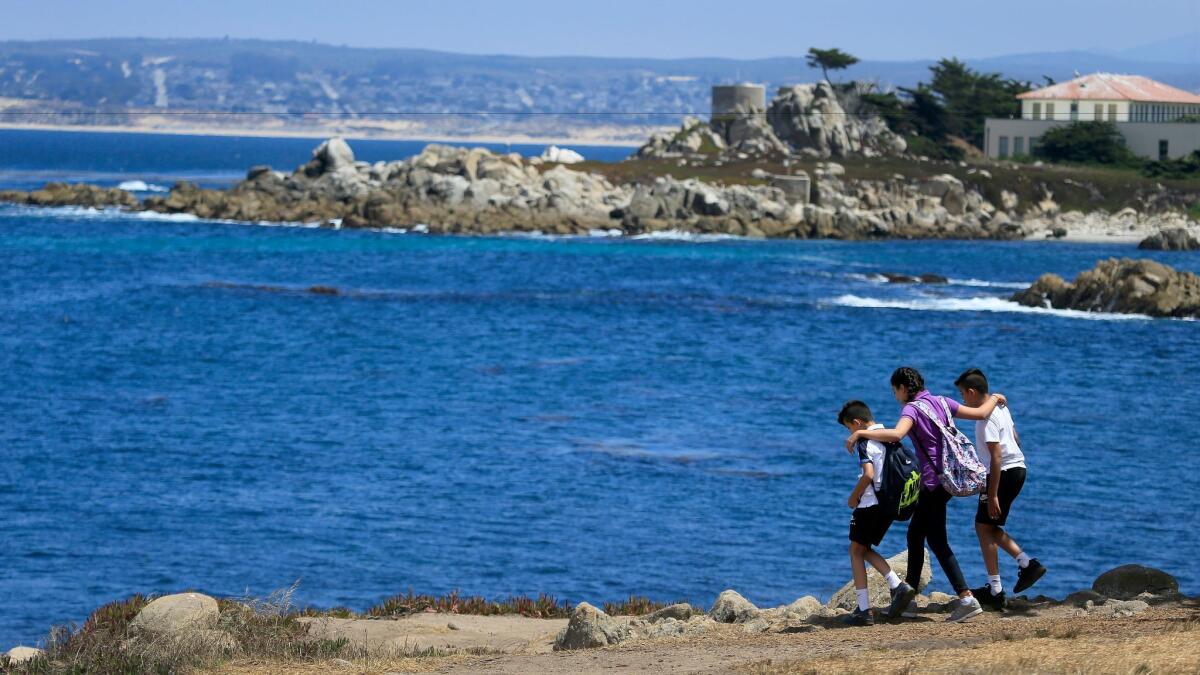Getting to the beach often comes down to one thing for people: Money

For years, property owners along the California coast have blocked public access to the shoreline with locked gates, fenced off easements, fake “no parking” signs and illegally constructed tennis courts.
Studies now show there is another major barrier to the surf and sand.
According to researchers at UCLA and San Francisco State, the costs of travel, parking and overnight accommodations discourage many Californians from going to the beach as often as they would like — especially low wage earners who live inland.
“This new research shows that we are at a tipping point where deciding to visit the coast is a close call for most Californians, given the cost,” said Jon Christensen, the study’s coauthor and a researcher at UCLA’s Institute of the Environment and Sustainability.
The report, called “The Cost of Visiting the Coast Keeps Many Californians Away,” was released Wednesday. It concluded that the expense of getting to the beach and staying there is becoming cost-prohibitive for many families, making the coast inaccessible to ordinary people.
Equitable access is not the same as equal access.
— Jose Gonzalez, founder of nonprofit Latino Outdoors
Researchers found, for example, that the average Californian is willing to pay about $118 per night for lodging in beach areas.
But according to the California Coastal Commission, a room at a budget hotel along the coast during the summer is between $135 and $260 a night.
The commission also reports that since 1989, about 24,720 economy rooms have been lost along the coast due to hotel and motel closures and remodels. Such affordable accommodations now make up only 5% of the rooms available in coastal areas.
Delving further into the economics of a simple day trip to the beach, the UCLA-San Francisco State study calculated that the average value of such an outing is $37, and the expense of traveling to the beach and home again is $22, a figure that does not include the costs of parking, food and activities.
If the cost of a typical trip were to go up and equal or exceed the $37 value, the increase would discourage many potential visitors from going to the beach, researchers concluded.
Surveys show that beachgoers in Orange, Los Angeles and Ventura counties often spend substantially more than $8.75 a day for parking alone — an amount greater than what potential visitors say they are willing to pay.
José González, the founder of Latino Outdoors, a national nonprofit organization, said the survey’s findings illustrate how difficult it is for low-income people to get to natural places, including the coast.
“Equitable access is not the same as equal access,” González said, “and it’s crucial for the long-term stewardship of our public coast that all of our communities feel that our coast and beaches truly belong to all and can be enjoyed as such.”
The research released Wednesday stems from the continued analysis of a public opinion survey done by UCLA and the Field Poll in November. The survey included 1,800 registered voters in California.
About 90% of those polled said the condition of the ocean and the state’s beaches is important to them, with 57% believing they are very important.
The results showed that 62% of those surveyed are concerned about limited access to the coastline, and larger majorities stated that a lack of public transit to the beach, affordable parking and affordable lodging are problems.
“Addressing these barriers to access is every bit as important as managing development and sea level rise, but they have historically received less attention,” said Philip King, an economics professor at San Francisco State and the study’s coauthor.
Researchers recommended that state government increase public transportation to the coast, encourage the construction of affordable overnight accommodations and create grant programs that help provide educational and recreational opportunities along the coast for low-income and middle-class families.
They also called for more affordable parking and adequate funding for coastal access programs run by the California Coastal Commission and state Coastal Conservancy.
“Over the years we have seen increasing pressure to build more higher-cost accommodations, even though Coastal Act policies are intended to protect and encourage lower-cost facilities,” said Effie Turnbull Sanders, the Coastal Commission’s vice chair. “The commission takes this very seriously because it’s getting difficult for even average families to visit our coast.”
Follow me on Twitter @LADeadline16
More to Read
Sign up for Essential California
The most important California stories and recommendations in your inbox every morning.
You may occasionally receive promotional content from the Los Angeles Times.











